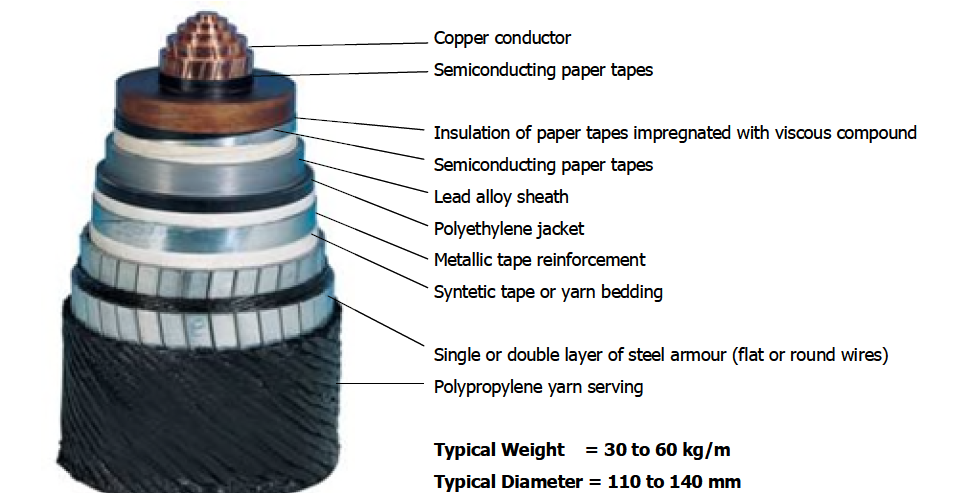HVDC Mass Impregnated (MI) cables are a very consolidated and traditional technology mainly deployed for subsea applications. Initially, MI cables were used with LCCs. Currently, this technology is mainly de-ployed for Extra High Voltage (EHV) DC subsea applications. MI cables are composed of a very high viscos-ity impregnating compound which does not cause leakage in the event of cable damage or failure. The latest innovation allows voltages of up to 600 kV.
Technology Types
There are three main types of cables based on the solution used to insulate the conductor: self-contained fluid-filled cables, paper insulated (lapped insulated) cables and extruded cables.
MI cables belong to the mass paper insulated cables types, which comprise:
- MI or paper-insulated lead-covered (PILC); the MI insulation consists of a MI paper with high-viscosity insulating compound.
- Paper polypropylene laminated (PPL) cables, where the insulation comprises an extruded sheet of polypropylene, on either side of which are bonded two layers of thin paper.
Components & enablers
The main components of MI HVDC cables are:
• The copper or aluminum (Al or Cu) Conductor
• The mass impregnated paper insulation
• The lead alloy sheath
• The overall protective plastic sheath (Polyethylene)
• The steel armour for submarine cables to improve the mechanical performance


Mass impregnated cables are compatible for the HVDC conversion systems available today, i.e. CSC and VSC.
Advantages & field of application
MI HVDC cables are currently the most used cables for HVDC submarine applications. Compared to oil filled cables, the compact design makes them particularly suitable for deep water applications. In contrast, their use for land applications is limited compared to extruded XLPE cables.
Benefiting from approximately 50 years of experience in service, with a proven high reliability, they can be provided by European manufacturers at voltages up to ± 600 kV and 1800 A, which makes approximately 2,200 MW per bi-pole.
Cable industry experts expect an improvement of this mature technology (underground and submarine) in several directions: an increase of power transmission level above 2300 MW for a dipole, reduced level of losses (consequence of the upgrading of operating voltage).
Technology Readiness Level
For on-shore (underground – corresponding to 5% of applications above 110 kV) and off-shore applications (submarine), a TRL 9 has been reached (System ready for full scale deployment at the current performance).
Research & Development
Current fields of research: Increase in power; reduction of losses; increase in water depth for submarine installations; alternatives for use of lead in sheath; ageing of mass impregnated insulation systems; increase the speed and manufacturing quality of the on-shore cable joints.
Innovation Priority: Voltage (up to 800 kV), maximum sea depth (over 2,500 m by 2050).
Best practice performance
For on-shore (underground) and off shore (submarine):
Maximum Installed Rating: 2,200 MW bi-pole (± 600 kV and 1,800 A)
Longest distance: no limitation, example of North Sea Link of 720 km (submarine, planned completion 2021)
Maximum sea depth (off-shore only): 1,000 m
Best practice application
Description
The NorNed HVDC MI sea cable interconnection between Norway and the Netherlands was completed in 2008. The rated DC voltage is ± 450kV DC and the transmission capacity is 700 MW. The entire link has a length of 580km.
Design
Impregnated non-draining, paper insulated HVDC cable. Two different designs are used: twin-core and single-core cable. Both cables consist of copper conductor(s) and a layer of semi-conducting carbon paper. [6]
Results
Denmark-Norway
as of end 2014
Description
The Denmark-Norway Interconnector (SKAGERRAK 4) is a joint project between Statnett and Energinet.dk. It is the first VSC connection at a voltage of ± 525 kV with a monopole MI cable of 700 MW. The transmission capacity is 715 MW and the water depth is 550 m.
Design
The submarine part of the cable is 137 km long and the underground directly buried portions in Denmark and Norway are 92 and 13 km respectively.
Results
The interconnector facilitates more renewable energy production in both countries and benefits consumers and the industry amongst others through more stable power prices and increased security of power supply.
North Sea - between Norway and UK
2021
Description
North Sea Link will be operational in 2021 and will be the longest subsea interconnector in the world. Capacity is 1.4 GW, length 720 km at a voltage of ± 515 kV.
Design
The major part will consist of two parallel HVDC submarine cables, buried 1 to 3 m into the seabed. On both sides a short distance of underground cable will also be constructed from the landfall to the converter station.
Results
Linking the two countries will provide opportunities to share renewable energy to meet new targets, will increase supply security and provide additional capacity.
References
[1] ENTSO-E, TYNDP 2018, Technologies for Transmission System, October 2019. [Link]
[2] Nexans. Submarine HVDC MI Cables by Nexans. [Link]
[3] Prysmian Group. Prysmian solutions for the expansion of energy grids. [Link]
[4] Statnett, nationalgrid. NorthSeaLink. [Link]
[5] O’Rourke P, Egan J, Sellick R, Tomlinson P, Johnson B, Svensson S. Overview of the 500MW EirGrid East-West Interconnector, considering System Design and Execution-Phase Issues. [Link]
[6] ABB. The NorNed HVDC Connection, Norway – Netherlands. [Link]
[7] 4C offshore. Skagerrak 4 Interconnector. [Link]
[8] Joint Research Center Technical reports. HVDC Submarine Power Cables in the World. [Link]
[9] Prysmian Power Link, 'Synthetic description of performances and benefits of undergrounding transmission’. [Link]
[10] Europacable, e-HIGHWAY 2050 project, Deliverable D3.1 ‘Technology assessment from 2030 to 2050’, Annex ‘Transmission Technologies - Cables’.[Link]
[11] Nexans, ‘Case Study – Skagerrak 4’. [Link]
[12] Prysmian Power Link, ‘High Voltage DC and submarine cable system- Practical considerations’. [Link]
[13] SINTEF Energy Research, ‘ Chemical ageing of subsea mass impregnated insulation cable paper [Link]
[14] ENTSOE, Offshore Transmission Technology, 24/11/2011 (update 16/10/2012). [Link]

